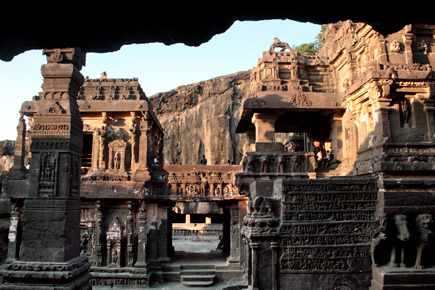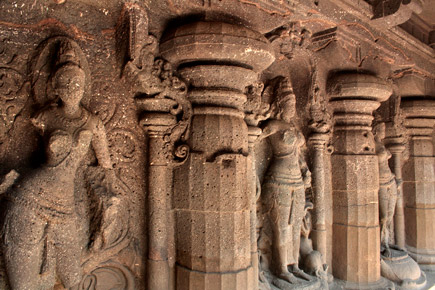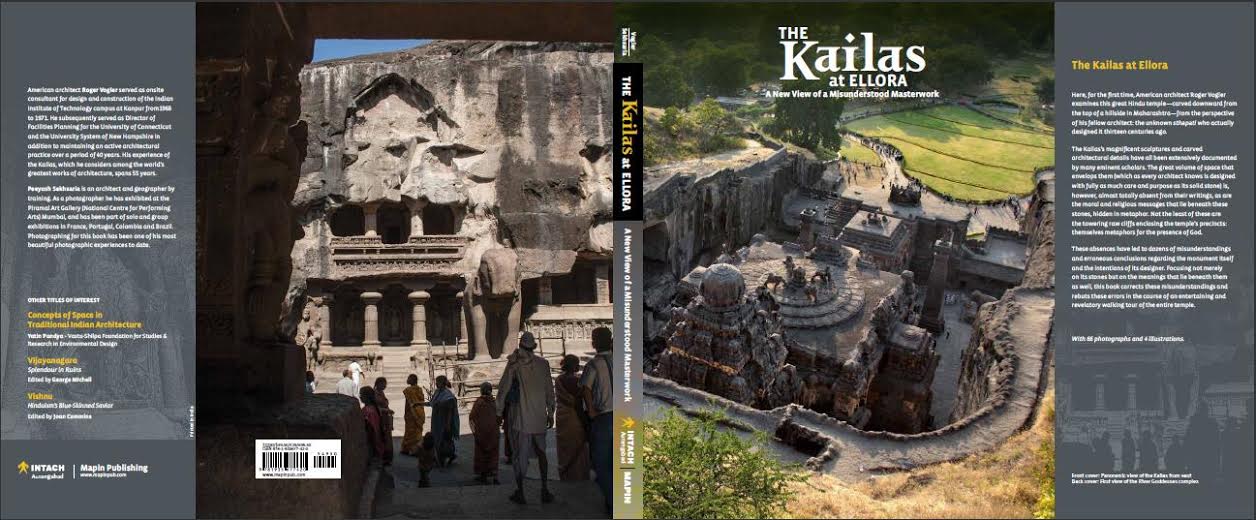Few days back, we announced the launch of the book: ‘The Kailas at Ellora’ by Roger Vogler and Peeyush Sekhsaria HERE. B. S. Keshav, who is passionate about History of Architecture, writes an elaborate and a critical review of the same, below.

B S Keshav is an architect, currently residing in Jaipur, Rajasthan. A graduate of Sir J J College of Architecture, Mumbai, he is currently teaching in a school of Architecture. Through his career, spanning 28 years, at various points in time, he has been a practising architect, Interior Designer & teacher, with History of Architecture being his favourite subject. He has also worked for an IT major looking after their Architectural & Interior Design projects across the country and abroad. Writing is his passion and he has one book published, titled Subbu Chronicles, apart from Short stories and essays published in various magazines.
BOOK REVIEW

“The Kailas at Ellora” by Architect Roger Vogler is a much-needed new look at a timeless masterpiece, arguably one of the greatest monuments amongst an exhaustive pantheon dotting the Indian peninsula.
The Kailas has been documented exhaustively by several eminent scholars over the last two hundred years. Tourists, students of Architecture, Conservationists and many more have trooped through its hallowed portals and still do. Each has carried an impression back. Most of the scholars have put forward their analysis of the stupendous monument. Some are more erudite than the others, but largely they agree with each other.

So the challenge before the author, when writing about a subject that has undergone so much scrutiny is immense. What new facet can he focus upon? What new light can he throw upon what has already been said so many times before?
The author has risen magnificently to the challenge. He has produced a treatise that should find pride of place in every Architectural school and office. This is no mere coffee table book. He backs each bold statement that he makes with detailed explanations in a language that any self-respecting architect should comprehend. Even the lay reader, who may not be an architect, should connect with this book.
The route taken by the author is three-fold.
To begin with, he has studied this structure himself and documented every nook and cranny. No sculpture, frieze, ornamentation or articulation has been ignored.
He then has studied all that has been written about the Kailas temple, till date by eminent people like James Ferguson, Percy Brown and many others. He even broadens his area of study to include works by architects such as Yatin Pandya, who has written about “Concepts of space in Indian Traditional Architecture”.
He quotes extensively from what has been written, giving credit where it is due and refuting, where it is merited.

His principal argument is that the structure, or sculpture, if it may be so portrayed, has been misunderstood all along. All authors, till date have pointed out that since it was carved downward from a living mountain, the resultant pit surrounding the structure is a basic flaw. Vogler argues passionately that far from being a flaw, this is its very strength. He focuses on the so-called negative space as being as much sculpted as the vimana or the dhwajastambha or the caves or the relief sculpture in the periphery. This space just wouldn’t 2 exist if the temple had been a freestanding structure, erected on plain land like a million other temples.
Experts have assigned reasons for this being carved into a mountain, saying that this was probably done because it would cost less. Vogler turns this argument on its head too, with cold, reasoned explanations. Cost, he says, could not have been the sole consideration. The creator of the temple is said to be King Krishna I or Krishnadevaraya I of the Rashtrakuta dynasty. The author argues that, given the extent of this king’s empire, it is highly unlikely that he would have had the time to conceive such a magnificent monument. Or that cost would have been a limitation. Instead, he must have been the patron and this was the brainchild of some unnamed Sthapati.
He then takes the reader on a virtual tour through the complex, starting with the fins projecting outside the Gopuram at the entrance. Each space is meticulously analysed and we get insights into the mind of the sthapati, who had conceived of and executed this monument all those hundreds of years ago. Each step in that journey is packed with scholarly insight.
Here we are presented with the second difference in approach that Vogler brings to the table. Where the physical attributes of the temple have been documented very well, the metaphors that they represent have not been taken into account. So we do have detailed accounts of “What” had been done. However the question of “Why” it had been done remains conjecture.
This has been addressed by Vogler very beautifully. A thorough study of the Hindu religion, through the Vedas, Upanishads, puranas and mythology is necessary to understand why this was done. Though he doesn’t go into too much detail, what he reveals is suggestive enough to delve into the psyche of the creators of this masterpiece.
Where this reviewer found a little confusion, is that the author did not dwell much upon the two distinct schools of temple architecture that evolved in the Indian subcontinent. One was the North-Indian or Nagara style. The other was the South-Indian or Dravida style. The Kailas undoubtedly belongs to the latter. The premier distinction between the two styles was the way in which the roof over the garbhagriha was treated. The Nagara style favoured the shikhara, which was a parabolic pyramid. The Dravida style had the vimana, which was a stepped pyramid. These terms have been used intermittently and may cause some confusion in the mind of a discerning reader.
He could also have been a little more critical about how the Archaeological Survey of India have made some needless additions and changes that ruin the experience of a visitor.
Apart from those minor flaws, all things considered, this is a wonderful addition to all the scholarly treatises on the great Kailas temple at Ellora. The illustrations and photographs are of excellent quality.
A must-read for all students and practitioners of Architecture.








2 Responses
Thanks to Architecture Live and Prof Kehav for this review and hoping that this starts a trend of a lot more book reviews on this wonderful forum